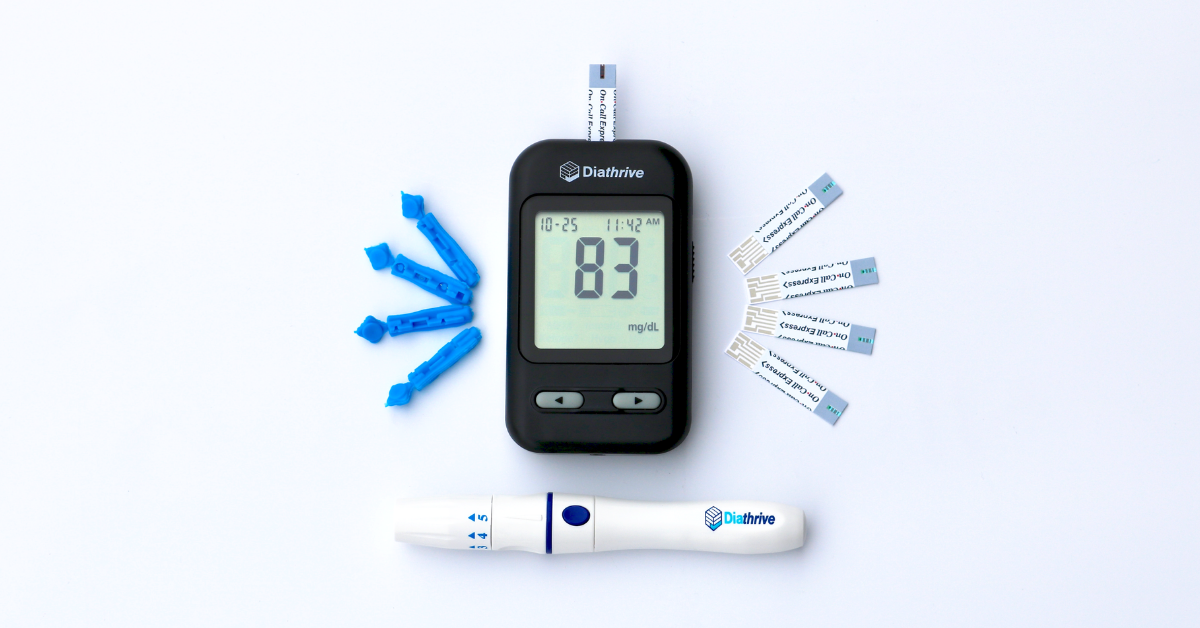
There's so much to know to manage type 1 diabetes and type 2 diabetes. But, once you learn, much of the tedious details become second nature. Let's take the guesswork out of blood sugar testing. Here's how to check your blood sugar levels.
All Diathrive blood glucose meters come with instructions on how to perform a blood glucose level check. Here we will talk about what is generally in the Diathrive glucose meter instruction manuals for at-home blood sugar checks, but we will also share some tips that you won't see in the manuals.
Basics: How to use your blood glucose meter
- Wash your hands with soap and warm water, and dry thoroughly with a clean towel.
- Insert a test strip into the strip port of your blood glucose meter, contact bars first, facing up.
- When you see the test strip and drop icon on your screen, the meter is ready for a blood sample to be applied.
- Using a fresh lancet, lance your fingertip (the side of your fingertip is best) and gently massage your finger from the base to the tip to obtain a small drop of blood.
- Apply the blood drop to the tip of the test strip. The test strip will automatically pull the blood into the sample chamber. If you don't get enough blood to fill the sample chamber on your first time, you have 3 seconds to massage a little more blood out and reapply.
- Watch the countdown on your meter screen. Your blood glucose reading will display when complete. Check to see if your reading is within your target range.
People experienced in diabetes care generally know these basics of self-monitoring. If you do not, spend some time with the user manual to make sure your process is allowing for accurate test results. These blood sugar test results will guide you, your healthcare provider, and your healthcare team through a successful management and treatment plan for your diabetes. Once you are comfortable with the basics, here are some additional tips and details to consider for the most accurate results.
Don't Forget About Gravity
Your heart circulates your blood around your body, but gravity also affects blood flow and blood pressure. Remember how a headstand will cause all your blood to rush to your head? The same is true of your fingers when you check your blood sugar. You will get more blood from your fingertip if you let your hand and arm hang down for a few minutes before and during your blood glucose testing procedure.
Change Your Lancet After Every Blood Sugar Check
Diathrive will send you as many lancets as you need to change your lancet every time you test. You can't see it with the naked eye, but every time you lance your fingers, the lancet bends a little and gradually becomes a microscopic fish hook. It will hurt more and may draw less blood. Learn more about lancets.
Drawing Blood
Finding the best depth setting and applying the right amount of pressure when you push the button on your lancing device can take a little time to figure out. If you are feeling too much pain or struggling to get enough blood, make small adjustments until it feels right. You may want to try adjusting the lancing device first. Most lancing devices have at least five settings. Usually the higher the setting number the deeper the needle will go when you fire the lancet.
If you want to give pricking your fingertips a rest, consider alternate site testing. Our meters are approved to read blood drawn from other areas, such as the forearm and palms. These areas have fewer nerve endings than your fingertips. If you choose to try these areas, our lancing device has a clear attachment with a wider opening for you to use. Be sure to use it if you decide to try alternate testing sites.
Remember that most modern meters require far less blood than older meters. Most meters will beep when they have sufficient blood to perform the blood glucose test, so try to draw a little more blood than you need to ensure good, full contact and avoid error codes. Do not apply the blood until you hear the beep or see the strip/blood icon appear.
Getting Better Blood Sugar Accuracy
Have you been surprised with your numbers after a blood sugar test, or have you even been suspicious of the result? Here are some tips for getting more accurate blood sugar readings.

